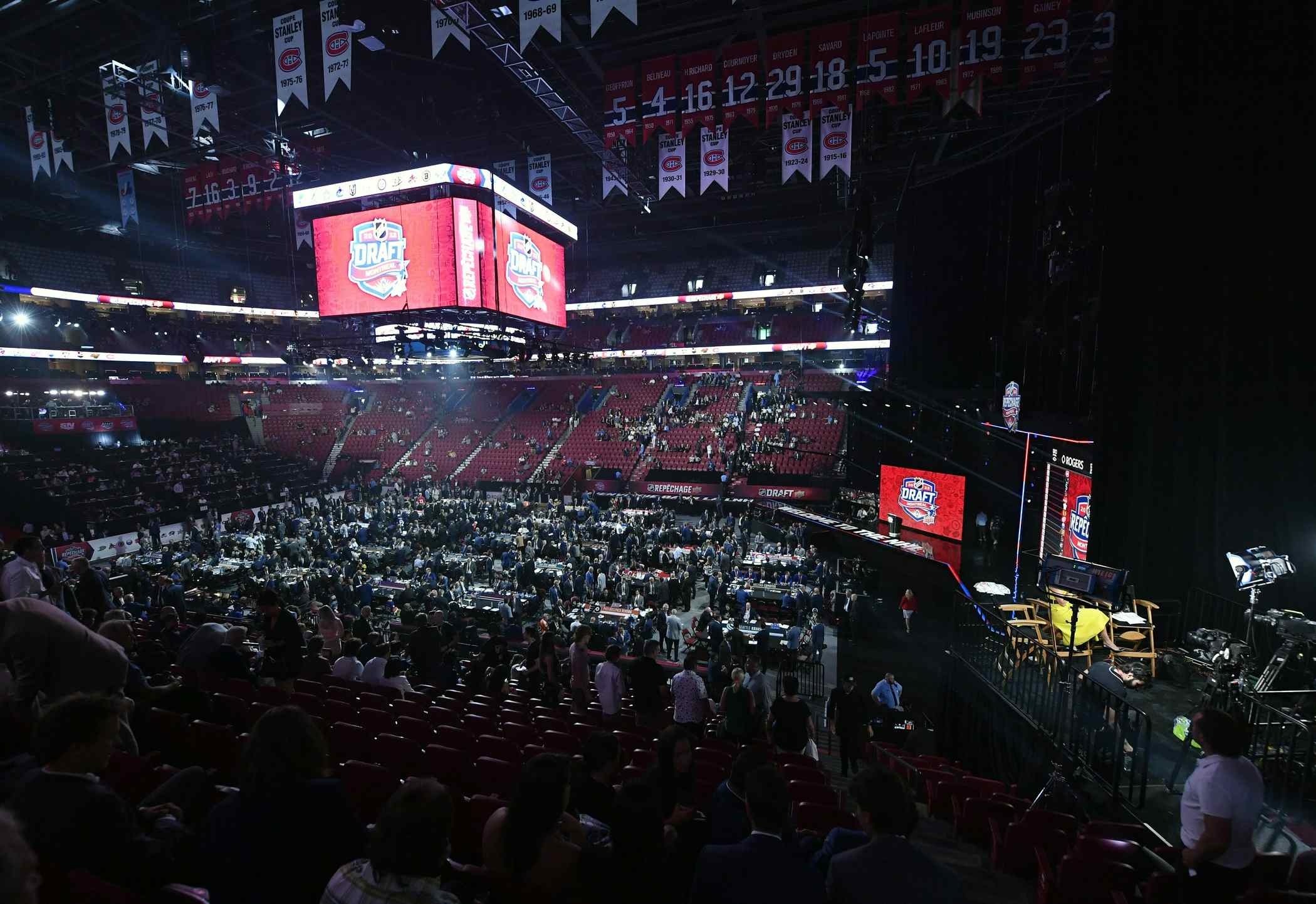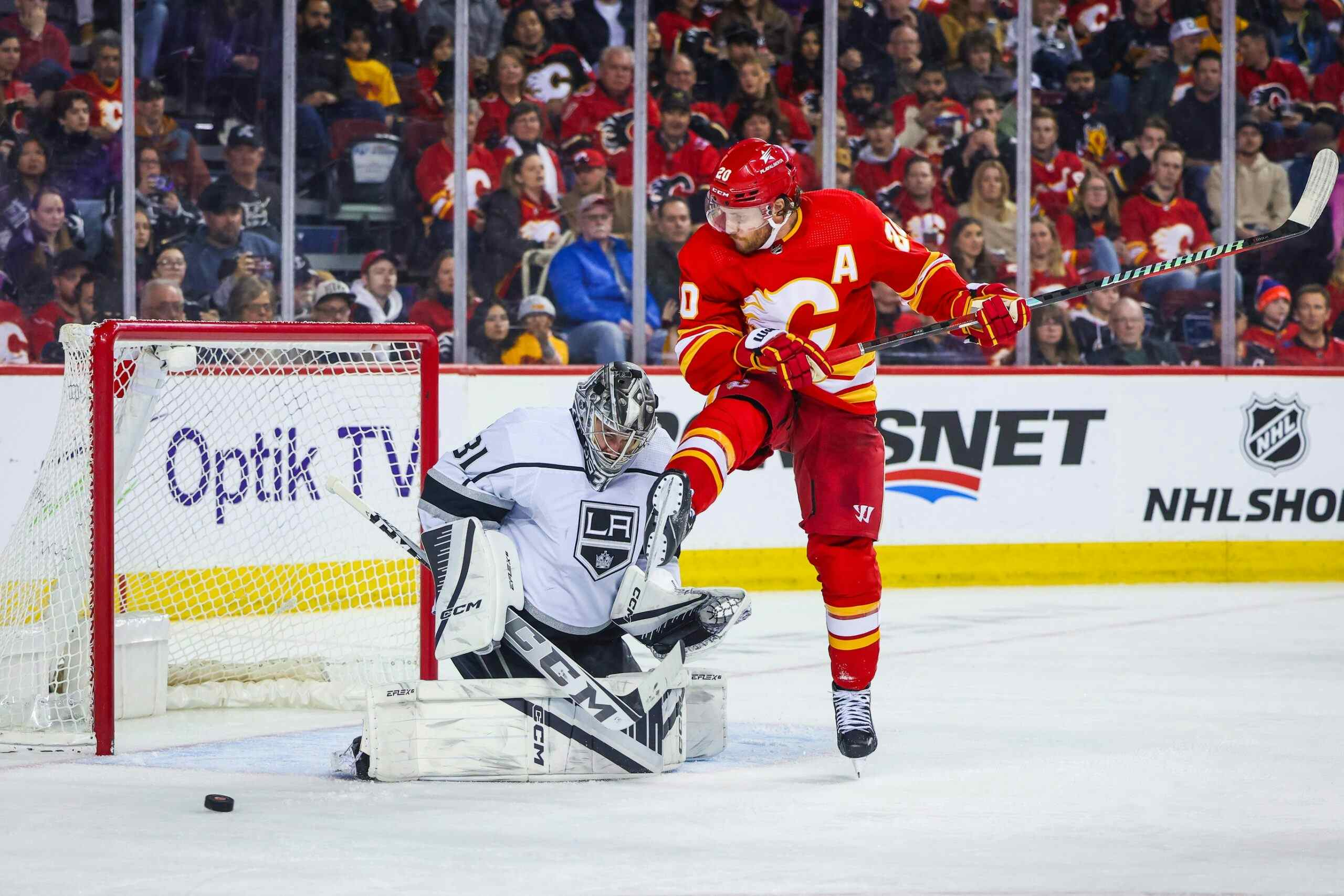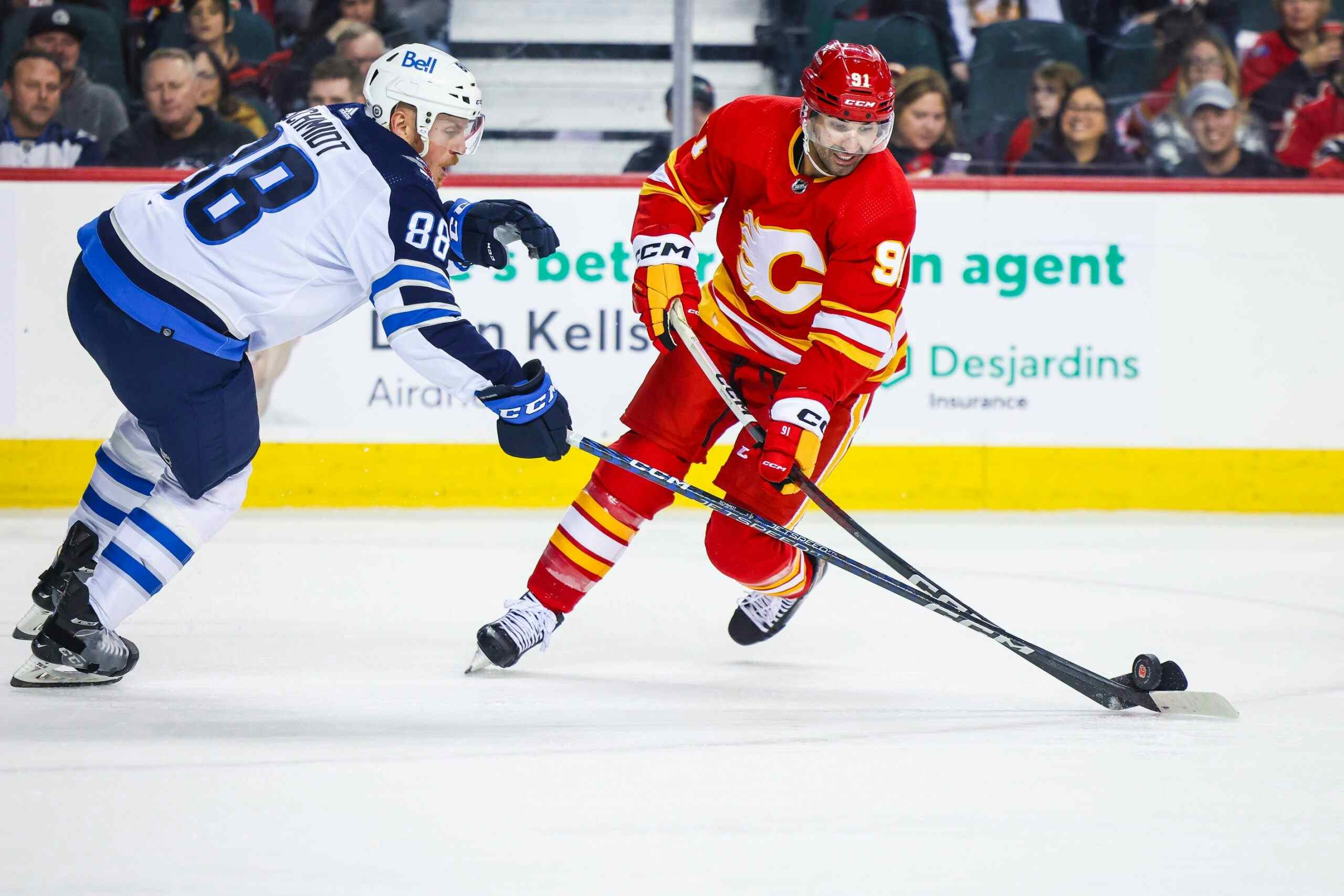Prospect progression comparisons: part 2, the 1990s kids

By Ryan Pike
2 years agoYesterday, we looked at the offensive progression of some of the Calgary Flames’ youngest prospects, the youngsters born in the 2000s. (Sorry for making everyone feel old.)
Today, we continue this look by going through the 1990s-born prospects by using an NHLe lens to examine their production.
A note
NHLe (NHL equivalent) is a offensive shorthand developed by the analytics community so they could have the ability to compare offensive production by players in different leagues. It’s essentially a tidy way of making the argument that “If Player X scored this much in League A, they would score about this much in the NHL,” and it’s based on past NHL production from players that made the jump from those leagues into the NHL.
It’s not perfect, but it’s only meant to be an approximation.
1999s
F Martin Pospisil
- Draft-1 (2016-17): n/a (31 points in 18 Austrian U18 games)
- Draft (2017-18): 17.33 (37 points in 49 USHL games)
- Draft+1 (2018-19): 32.87 (63 points in 44 USHL games)
- Draft+2 (2019-20): 15.33 (10 points in 26 AHL games)
- Draft+3 (2020-21): 31.31 (11 points in 14 AHL games) & n/a (17 points in 22 Slovakian games)
Pospisil had the traditional “first-year pro” dip last season, but he had a really strong bounce-back sophomore campaign before his injury trouble set in. If he can stay healthy, he could be a really valuable asset for the Flames.
F Adam Ruzicka
- Draft-1 (2015-16): n/a (8 points in 3 U18 games & 35 points in 34 U20 games)
- Draft (2016-17): 19.97 (46 points in 61 OHL games)
- Draft+1 (2017-18): 30.27 (72 points in 63 OHL games)
- Draft+2 (2018-19): 31.78 (78 points in 65 OHL games)
- Draft+3 (2019-20): 19.93 (27 points in 54 AHL games)
- Draft+4 (2020-21): 29.29 (21 points in 28 AHL games)
Ruzicka has been really effective post-draft, and especially in making progression across two AHL seasons. He’s likely in the mix for an NHL gig before too long if he maintains his offensive production.
F Filip Sveningsson
- Draft-1 (2015-16): 4.32 (3 points in 11 U20 Superelit games) & n/a (41 points in 34 U18 games)
- Draft (2016-17): 0.00 (0 points in 2 SHL games), 12.40 (29 points in 37 U20 Superelit games) & n/a (1 point in 1 U18 games)
- Draft+1 (2017-18): 0.00 (0 points in 11 SHL games) & 17.63 (39 points in 35 U20 Superelit games)
- Draft+2 (2018-19): 20.44 (27 points in 43 HockeyAllsvenskan games)
- Draft+3 (2019-20): 6.74 (4 points in 29 SHL games) & 16.28 (4 points in 8 HockeyAllsvenskan games)
- Draft+4 (2020-21): 9.30 (14 points in 49 HockeyAllsvenskan games)
Sveningsson’s NHL rights will lapse this season, but we’ve included him here to illustrate why: he’s all over the damn place. Two seasons ago he seemed like he could be a valuable prospect with a 20+ NHLe, but his offensive numbers have totally cratered. Yes, some of that may have been his usage in the Swedish pro leagues, but he just didn’t make the adjustments necessary to turn the proverbial corner.
1998s
F Mitchell Mattson
- Draft-1 (2014-15): n/a (63 points in 46 high school games) & 12.36 (7 points in 12 USHL games)
- Draft (2015-16): n/a (46 points in 25 high school games) & 2.18 (2 points in 21 USHL games)
- Draft+1 (2016-17): 11.69 (28 points in 55 USHL games)
- Draft+2 (2017-18): 9.10 (21 points in 53 USHL games)
- Draft+3 (2018-19): 0.00 (0 points in 14 NCAA games)
- Draft+4 (2019-20): 1.24 (1 point in 22 NCAA games)
- Draft+5 (2020-21): 5.20 (4 points in 21 NCAA games)
Mattson’s numbers are consistently blah. He’s had five points in the NCAA over three seasons. He’s headed into his senior year and barring a gigantic change of pace, he’s not likely to be signed by the Flames following the season.
F Matthew Phillips
- Draft-1 (2014-15): n/a (73 points in 34 AMHL games) & 37.15 (3 points in 2 WHL games)
- Draft (2015-16): 26.14 (76 points in 72 WHL games)
- Draft+1 (2016-17): 31.84 (90 points in 70 WHL games) & 39.85 (1 point in 1 AHL game)
- Draft+2 (2017-18): 39.06 (112 points in 71 WHL games)
- Draft+3 (2018-19): 23.30 (38 points in 65 AHL games)
- Draft+4 (2019-20): 34.61 (33 points in 38 AHL games)
- Draft+5 (2020-21): 27.90 (21 points in 30 AHL games)
It’s a bit nuts that Phillips was available when he was in his draft year, because the kid simply can score. At every level. A lot. His first-year pro dip was from excellent production down to merely very good production, and he’s been a model of consistency since his draft year.
E Eetu Tuulola
- Draft-1 (2014-15): n/a (28 points in 33 U20 games & 2 points in 5 U18 games)
- Draft (2015-16): n/a (14 points in 29 U20 games) & 3.70 (1 point in 10 SM-Liiga games)
- Draft+1 (2016-17): 12.38 (31 points in 62 WHL games)
- Draft+2 (2017-18): 18.85 (26 points in 51 SM-Liiga games)
- Draft+3 (2018-19): 22.19 (36 points in 60 SM-Liiga games)
- Draft+4 (2019-20): 18.33 (23 points in 50 AHL games)
- Draft+5 (2020-21): 9.62 (7 points in 29 AHL games), 8.88 (3 points in 11 HockeyAllsvenskan games) & 0.00 (0 points in 4 SM-Liiga games)
The Flames likely drafted Tuulola for his size and potential, and you can almost see why: he’s made progress since being drafted and wobbled around that 20.00 NHLe level, but he’s just not been able to build consistency. This season may be a bit of a wash, as he bounced around between leagues and ended up as a bit of a depth piece in Stockton due to a forward logjam.
1997s
F Walker Duehr
- Draft-1 (2014-15): 3.28 (7 points in 49 USHL games)
- Draft (2015-16): 13.90 (23 points in 38 USHL games) [Not drafted]
- Draft+1 (2016-17): 13.46 (34 points in 58 USHL games)
- Draft+2 (2017-18): 12.92 (3 points in 8 NCAA games)
- Draft+3 (2018-19): 16.21 (16 points in 34 NCAA games)
- Draft+4 (2019-20): 16.14 (15 points in 32 NCAA games)
- Draft+5 (2020-21): 20.91 (17 points in 28 NCAA games) & 0.00 (0 points in 5 AHL games)
If nothing else, Duehr has been a consistent producer and made a bit of progress offensively during his four years in college. Players that score like him at lower levels tend to be depth pieces as pros, though.
F Glenn Gawdin
- Draft-1 (2013-14): 8.25 (22 points in 66 WHL games)
- Draft (2014-15): 18.57 (54 points in 72 WHL games)
- Draft+1 (2015-16): 24.76 (53 points in 53 WHL games)
- Draft+2 (2016-17): 28.10 (59 points in 52 WHL games)
- Draft+3 (2017-18): 46.20 (125 points in 67 WHL games)
- Draft+4 (2018-19): 23.66 (38 points in 64 AHL games)
- Draft+5 (2019-20): 35.34 (47 points in 53 AHL games)
- Draft+6 (2020-21): 23.55 (13 points in 22 AHL games), 0.00 (0 points in 1 Swiss game) & 13.67 (1 point in 6 NHL games)
Gawdin’s 2017-18 season is just bonkers – his line was the top offensive line in all of junior hockey – but he’s been a consistently good hand with really nice offensive numbers. Heck, his first-year pro dip wasn’t terribly large and he’s managed to get a point in the NHL, too. He’s trending well.
D Johannes Kinnvall
- Draft-1 (2013-14): n/a (0 points in 1 U20 game & 7 points in 25 U18 games)
- Draft (2014-15): n/a (0 points in 1 U20 game, 3 points in 1 Div 3 game & 21 points in 29 U18 games) [Not drafted]
- Draft+1 (2015-16): 3.09 (8 points in 41 U20 Superelit games)
- Draft+2 (2016-17): 0.00 (0 points in 21 SHL games) & 8.79 (20 points in 36 U20 Superelit games)
- Draft+3 (2017-18): 7.97 (12 points in 49 HockeyAllsvenskan games)
- Draft+4 (2018-19): 20.68 (22 points in 52 SHL games)
- Draft+5 (2019-20): 38.33 (40 points in 51 SHL games)
- Draft+6 (2020-21): 33.60 (22 points in 32 SHL games)
Kinnvall didn’t put up impressive offensive production until his fourth post-draft season, at which point NHL teams started getting excited about him. It’ll be interesting to see how much of a dip he sees in the AHL next season.
D Carl-Johan Lerby
- Draft-1 (2013-14): n/a (7 points in 31 U18 games)
- Draft (2014-15): 2.55 (5 points in 31 Superelit games) & n/a (14 points in 23 U18 games) [Not drafted]
- Draft+1 (2015-16): 0.00 (0 points in 5 SHL games), n/a (1 point in 2 HockeyEttan games) & 6.92 (14 points in 32 Superelit games)
- Draft+2 (2016-17): 4.34 (4 points in 45 SHL games), 9.30 (2 points in 7 HockeyAllsvenskan games) & 11.30 (5 points in 7 Superelit games)
- Draft+3 (2017-18): 13.33 (6 points in 22 SHL games) & 6.51 (1 point in 5 HockeyAllsvenskan games)
- Draft+4 (2018-19): 21.84 (21 points in 47 SHL games)
- Draft+5 (2019-20): 17.77 (16 points in 44 SHL games)
- Draft+6 (2020-21): 12.68 (7 points in 22 AHL games)
Lerby’s been sort of all over the place production-wise since his draft year. He became Stockton’s seventh defender during the season.
G Tyler Parsons
- Draft-1 (2014-15): .905 in 33 OHL games
- Draft (2015-16): .921 in 49 OHL games
- Draft+1 (2016-17): .925 in 34 OHL games
- Draft+2 (2017-18): .856 in 7 AHL games & .902 in 28 ECHL games
- Draft+3 (2018-19): .898 in 20 AHL games
- Draft+4 (2019-20): .911 in 25 ECHL games
- Draft+5 (2020-21): .800 in 1 AHL game
Parsons has battled injuries and inconsistency since being drafted. He tends to be better when he plays a lot, which suggests that he may find consistency if he can stay healthy.
The rest
Justin Kirkland’s draft year was 2013-14. In five years of pro hockey primarily in the AHL, he’s wobbled around the 20.00 NHLe level.
Connor Mackey’s draft year was 2013-14. His offensive numbers built to the low 20s (NHLe) in college and in his debut pro season, he avoided the traditional dip we see in first-year pros. (His NHLe was actually up a little bit.)
Alexander Yelesin’s draft year was 2013-14. His offensive numbers were never terribly impressive, but he emerged as a reliable KHL defender in his Draft+3 season. Offensively, he’s basically the same player in the AHL as he was in the KHL.
Luke Philp’s draft year was 2013-14. He was a really reliable WHL scorer, with over a point per game in his final three seasons. He was over a point per game in two USports seasons and he’s been a consistent 20+ NHLe player in two AHL seasons. If nothing else, he’s consistent.
Colton Poolman’s draft year was 2013-14. His offensive numbers never popped until his Draft+2 season in the BCHL and then he was a consistently reliable two-day defender, albeit with unspectacular offensive production, in the NCAA. He had a bit of a production dip in the AHL this season.
Artyom Zagidulin’s draft year was 2012-13. He didn’t have a season of more than 10 games and a .920+ save percentage until his Draft+5 season in the VHL. He’s been a reliable AHL goalie, but his save percentages – .898 and .911 – haven’t been spectacular.
Recent articles from Ryan Pike





